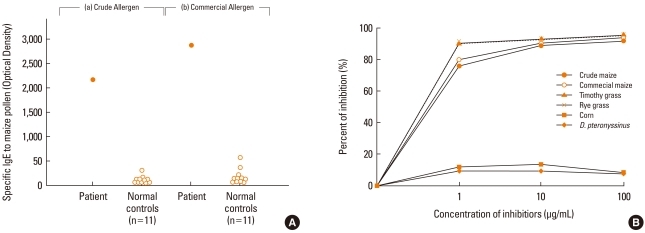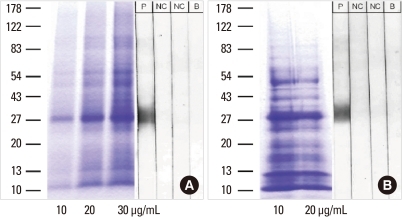Abstract
Corn is a major staple food, along with rice and wheat, in many parts of the world. There are several reports of hypersensitivity to maize pollen. However, cases of occupational allergic rhinitis induced by inhalation of maize pollen are very rare. We herein report the case of a 67-year-old male with occupational rhinitis caused by occupational exposure to maize pollen in a cornfield. He showed positive responses to maize pollen, as well as grass pollens, in skin prick tests. A high level of serum immunoglobulin E (IgE) specific to maize pollen extracts was detected by an enzyme-linked immunosorbent assay (ELISA). Laboratory tests showed a high serum level of total IgE (724 kU/L) and a high level of IgE specific to maize pollen (8.32 kU/L) using the Immuno-CAP system. Occupational rhinitis was confirmed by a nasal provocation test with maize pollen extracts. IgE ELISA inhibition tests showed antibody cross-reactivity between maize pollen and grass pollen extracts. IgE immunoblotting using maize pollen extracts demonstrated a 27 kDa IgE-binding component. These findings suggest that maize pollen can induce IgE-mediated occupational rhinitis in exposed workers.
Keywords: Grass pollen, immunoglobulin E, maize pollen, nasal provocation test, occupational rhinitis
INTRODUCTION
Maize (Zea mays) is an annual plant that belongs to the order Poales, family Poaceae. Maize pollen disperses during the period between July and August for 5-8 days per branch. Maize pollen is 5-200 µm in diameter, the pollen transport distance is 50-200 m, and its settling speed is 0.31 m/second.1-3
Gonzalo-Garijo et al.4 reported a case of hypersensitivity to maize pollen, and Freeman reported cases of oral corn pollen hypersensitivity in Americans that received allergen-specific immunotherapy.5 However, there have been no known reports of occupational rhinitis induced by maize pollen. Here, we report a case of occupational rhinitis that developed in a 67-year-old maize farmer.
CASE REPORT
A 67-year-old man visited our clinic with a two week history of persistent paroxysmal cough. Clinical symptoms, such as sneezing, rhinorrhea, itchy nose and eyes, urticaria, and cough had occurred since he was 40 years of age while working in the cornfield, particularly in July through August when the flowers blossomed. These clinical symptoms were improved upon resting outside the cornfield. He had worked as a professional farmer in corn and potato fields since he was 26 years of age. The corn cultivation area was 6,600 m2.
On physical examination, there were no abnormal lung or heart sounds. At presentation, hematological tests of peripheral blood revealed 14.0 g/dL hemoglobin, 4,730/µL white blood cells (eosinophils, 0.6%), and 214,000/µL platelets. The total serum immunoglobulin E (IgE) level was 724 kU/L. Skin prick tests were performed using a total of 55 inhalant allergens, including maize pollen and food allergens. The test results, interpreted on the basis of the allergen/histamine (A/H) ratio, were positive as follows: meadow grass (6+), orchard grass (5+), timothy grass (5+), rye grass (3+), maize pollen (3+), and mugwort pollen (6+). Serum specific IgE, measured using the Immuno-CAP system (Phadia, Uppsala, Sweden), was strongly positive (class ≥3) for meadow grass, timothy grass, and maize pollens. Spirometry measured the forced expiratory volume at 1 second (FEV1; 2.92 L or 122%), forced vital capacity (FVC; 3.96 L or 116%), FEV1/FVC (74%), and residual volume (RV; 2.06 L or 102%). The methacholine bronchial challenge test result was negative. To confirm that allergic rhinitis was induced by maize pollen, maize pollen was collected and a nasal provocation test was performed (Fig. 1). Sneezing occurred 90 minutes after nasal provocation. Watery rhinorrhea, sneezing, nasal blockage, and eye itching persisted for 12 hours; thereafter, these symptoms progressively disappeared. Specific IgE antibodies to maize pollen were measured by enzyme-linked immunosorbent assay (ELISA) using crude maize pollen extract, which we collected and extracted, as well as a commercial maize pollen typically used in skin prick tests (Bencard, Munich, Germany). Serum specific IgE antibody levels to the crude and commercial maize pollen extracts were measured using sera obtained from the patient and 11 normal (healthy) subjects without allergic diseases. Specific IgE antibody titers to the two extract types were higher in the patient than in the healthy subjects (Fig. 2A). To confirm the antibody specificity for crude maize pollen, 10 µg/mL crude maize pollen, commercial maize pollen, timothy grass pollen, rye grass pollen, corn allergen, and Dermatophagoides pteronyssinus allergen were used in IgE-ELISA inhibition tests. Positive concentration-response curves were obtained for the two types of maize pollens, as well as for timothy and rye grass pollens. An 80% inhibition was observed at allergen concentrations of ≥1 µg/mL (Fig. 2B). Sodium dodecyl sulfate polyacrylamide gel electrophoresis (SDS-PAGE) revealed multiple protein bands between 10 and 83 kDa in the two kinds of maize pollens, and the protein bands grew denser as the amount of allergen increased. IgE immunoblotting with sera from the patient and two normal control subjects revealed a protein band of 27 kDa (Fig. 3).
Fig. 1.
Maize pollen nasal provocation test. The patient stood in a room for 15 min while pouring maize pollen into each hand with a cup.
Fig. 2.
(A) Serum specific immunoglobulin E (IgE) antibodies to (a) crude maize pollen and (b) commercial maize pollen were measured by enzyme-linked immunosorbent assay (ELISA) using sera from our patient (●) and 11 normal controls (○). (B) Crude maize pollen-specific IgE was confirmed in patient sera by ELISA inhibition tests using crude maize pollen (●), commercial maize pollen (○), timothy grass pollen (▲), rye grass pollen (×), corn (■), and Dermatophagoides (D.) pteronyssinus (◆) allergens.
Fig. 3.
Sodium dodecyl sulfate polyacrylamide gel electrophoresis and immunoglobulin E immunoblotting assays were performed with (A) crude and (B) commercial maize pollens using sera from our patient, sera from normal controls, and a buffer control. P, our patient; NC, normal controls; B, buffer control.
DISCUSSION
Our patient was diagnosed with IgE-mediated occupational rhinitis based on the following findings: (i) his symptoms were evident only during maize season and time spent in the cornfield, (ii) skin prick tests showed a positive response for maize pollen, (iii) IgE antibodies specific to maize pollen were detected using the Immuno-CAP system as well as ELISA, and (iv) the nasal provocation test showed a positive response with maize pollen.
IgE-mediated occupational allergic diseases manifest clinical symptoms after a certain period of exposure, which varies according to the offending allergen. For example, it typically takes one year of exposure to develop allergies to rice powder,6 5 years for olive pollen,7 5 years for sunflower pollen,8 and 7 years for wheat.9 The incubation period can range from several weeks to ≥20 years.10 High molecular weight allergen-induced allergic diseases usually manifest symptoms of rhinitis and conjunctivitis before the appearance of asthma symptoms.11 Our patient presented with clinical symptoms after an incubation period of 14 years, which is longer than those with allergic diseases caused by other grain allergens. The reasons for this may include a short transport time, difficulty for the allergen in reaching the airways, and the short settling time of maize pollen, which can be as large as 90 µm in diameter.
In this patient, SDS-PAGE and IgE immunoblotting identified a 27 kDa protein band in both crude and commercial maize pollens. It is believed that commercial maize pollen contains the major allergenic component of maize pollen that prevails in Korea. Therefore, it serves as a sufficient substitute for crude maize pollen allergen. Like maize, grass species belong to the order Poales, family Poaceae, and allergens from grass pollen have 13 protein bands, ranging from 9 to 60 kDa, among which bands of 30 kDa (Lo1 p 1) and 29-31 kDa (Lo1 p 5) correspond to the main allergens.12 In this case, the skin prick test showed a positive response to grass pollen as well as maize pollen. Antibody cross-reactivity between grass and maize pollens was identified using the IgE-ELISA test. The reason for this cross-reactivity may be that these two pollens belong to the same order and family.
In summary, corn has been cultivated worldwide, including in Gangwon province and its vicinity in Korea. Therefore, it is possible that maize pollen is a cause of occupational rhinitis in Gangwon province. Here, we reported a case of occupational rhinitis induced by maize pollen that was mediated by IgE.
Footnotes
There are no financial or other issues that might lead to conflict of interest.
References
- 1.Goss JA. Development, physiology, and biochemistry of corn and wheat pollen. Bot Rev. 1968;34:333–359. [Google Scholar]
- 2.Aylor DE. Settling speed of corn (Zea mays) pollen. J Aerosol Sci. 2002;33:1601–1607. [Google Scholar]
- 3.Pleasants JM, Hellmich RL, Dively GP, Sears MK, Stanley-Horn DE, Mattila HR, Foster JE, Clark P, Jones GD. Corn pollen deposition on milkweeds in and near cornfields. Proc Natl Acad Sci U S A. 2001;98:11919–11924. doi: 10.1073/pnas.211287498. [DOI] [PMC free article] [PubMed] [Google Scholar]
- 4.Gonzalo-Garijo MA, Pérez-Calderón R, Muñoz-Rodríguez A, Tormo-Molina R, Silva-Palacios I. Hypersensitivity to maize pollen. Allergy. 2004;59:365. doi: 10.1046/j.1398-9995.2003.00396.x. [DOI] [PubMed] [Google Scholar]
- 5.Freeman GL. Oral corn pollen hypersensitivity in Arizona Native Americans: some sociologic aspects of allergy practice. Ann Allergy. 1994;72:415–417. [PubMed] [Google Scholar]
- 6.Kim JH, Kim JE, Choi GS, Hwang EK, An S, Ye YM, Park HS. A case of occupational rhinitis caused by rice powder in the grain industry. Allergy Asthma Immunol Res. 2010;2:141–143. doi: 10.4168/aair.2010.2.2.141. [DOI] [PMC free article] [PubMed] [Google Scholar]
- 7.Palomares O, Fernández-Nieto M, Villalba M, Rodríguez R, Cuesta-Herranz J. Occupational allergy in a researcher due to Ole e 9, an allergenic 1,3-beta-glucanase from olive pollen. Allergy. 2008;63:784–785. doi: 10.1111/j.1398-9995.2008.01680.x. [DOI] [PubMed] [Google Scholar]
- 8.Atis S, Tutluoglu B, Sahin K, Yaman M, Küçükusta AR, Oktay I. Sensitization to sunflower pollen and lung functions in sunflower processing workers. Allergy. 2002;57:35–39. [PubMed] [Google Scholar]
- 9.Barraclough R, Bradshaw L, Barber C, Curran A, Fishwick D. Latent period for symptomatic sensitization in bakeries. Occup Med (Lond) 2005;55:580. doi: 10.1093/occmed/kqi131. [DOI] [PubMed] [Google Scholar]
- 10.Chan-Yeung M. Occupational asthma. Chest. 1990;98:148S–161S. doi: 10.1378/chest.98.5_supplement.148s. [DOI] [PubMed] [Google Scholar]
- 11.Malo JL, Lemière C, Desjardins A, Cartier A. Prevalence and intensity of rhinoconjunctivitis in subjects with occupational asthma. Eur Respir J. 1997;10:1513–1515. doi: 10.1183/09031936.97.10071513. [DOI] [PubMed] [Google Scholar]
- 12.Stewart GA. The structure and function of allergens. In: Adkinson NF Jr, Bochner BS, Busse WW, Holgate ST, Lemanske RF Jr, Simons FE, editors. Middleton's allergy: principles & practice. Philadelphia: Elsevier; 2009. pp. 569–608. [Google Scholar]





